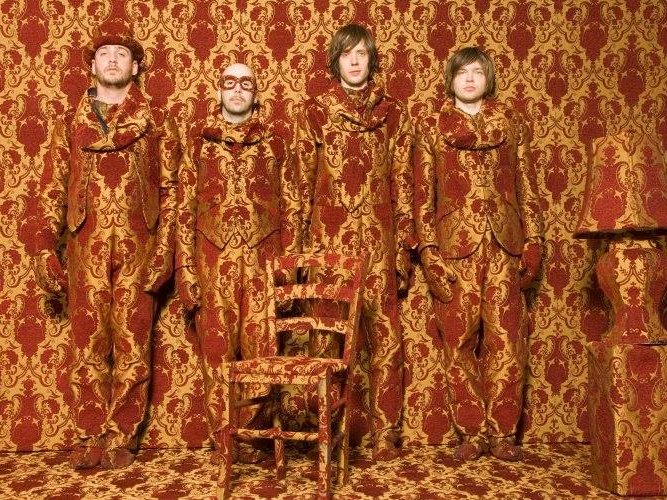The OnMilwaukee.com Summer Festivals Guide is presented by Pick 'n Save, Where Wisconsin Saves on Groceries. Pick 'n Save is Wisconsin proud, and excited to help promote and feed the great Milwaukee summer that includes festivals and fun nearly every day. Click to save here!
Most bands desperately hope that their music videos will go viral. For OK Go, at this point, it's almost expected.
From treadmill choreography to mind-bending eye tricks to massive Rube Goldberg machines to musical test drives to choreographed dogs, the power pop rockers have mastered the art of crafting insanely elaborate videos, often captured in seemingly one long take – and often capturing millions upon millions of clicks after hitting YouTube. They're often so clever and inventive that it's sometimes easy to take for granted OK Go's fun, hooky rock tunes providing the soundtrack.
Does that ever concern the band, the potential that some might think the group's videos come first and the music second? With an upcoming Summerfest headliner gig set for the Uline Warehouse on Thursday, July 2, I asked that question to OK Go bassist and vocalist Tim Nordwind (who, along with fellow bandmate Dan Konopka, will also be performing a post-Big Gig DJ set under the name Xia Xia Technique at Oak), as well as found out some of the stories behind the band's short film sensations.
OnMilwaukee.com: Where do you get the ideas from for your music videos?
Tim Nordwind: We don’t have, like, a secret well or anything like that. (laughs) A lot of the ideas just come throughout the years. We’ve spent a lot of sort of monotonous time together in buses, on planes, in dressing rooms and things like that. So we get pretty shack-wacky, and we start just talking about a lot of weird what-ifs.
Honestly, some of it comes from the people we collaborate with who pitch ideas that are really interesting. Some of it just comes from things we see in the world that we think are pretty awesome, and we wonder, like, what if you could do this idea but synchronized to music and with some kind of choreography going on.
The ideas themselves – the concepts, the simple one or two lines you put down on a piece of paper like "We’re going to do a choreographed dance with dogs" or "We’re going to build a gigantic Rube Goldberg machine" – I don’t want to say that’s the easy part, but the more challenging part comes in the period in which we play with these ideas and actually have to put something together that’s three and a half minutes of feeling and emotion, something that’s visually stimulating and something that marries well with the music we’re playing. It’s a big, long process.
OMC: Which video has been the most challenging to make?
TN: I think in the sense of marrying sight and sound in an effective way, I think "Needing/Getting" was our most complicated video. It’s us driving a car that has robotic arms stuck to it, and we’re driving over two and a half miles of, like, a musical obstacle course in the desert. When we drive past all these things, the robotic arms play all these homemade instruments that are tuned to the song.
That was very hard, from just figuring out what homemade instruments we could make that could be tuned and last outdoors in the desert and testing that kind of thing at first. Then building the obstacle in the desert, of course, took quite a bit of time. Damian (Kulash, guitarist and lead vocalist) had to take stunt driving lessons. Then we had dozens of microphones all over the car and the obstacle course that were picking up the sounds, but at the end of the day, we had over 7,000 tracks of sound that we had to make into an audible song (laughs) that made sense to the average listener. So that was just incredibly difficult task – in pre-production, in shooting and in post-production.
OMC: Because of all of that, is that your favorite video, or is it a different one?
TN: It really is hard to pick favorites. You know, they all represent different things to me, so it’s hard for us to come up with a favorite, because so much of the process of making these things, I think, informs how we feel about the end product. Whereas I think anyone else just gets to watch the thing that’s made, for me, when I look at these things, it’s hard not to remember the emotions we were feeling while we were rehearsing it and building it and filming it. As fun and as joyful as I think a lot of these videos end up being, there really are some very frustrating and difficult moments in the making of them. (laughs)
I think the ones that were just the four of us and a camera, those are the ones that I remember with the most nostalgia and fondness. The video for "A Million Ways" where we’re just dancing in Damian’s backyard or "Here It Goes Again" where we’re on the treadmills; I mean that was us and Damian’s sister Trish – who helped choreograph all of these things – and a camera. There’s something about how those were truly just the guys, doing what we would’ve done anyways.
But the bigger ones are such behemoths, and they’ve all been such behemoth challenges that there’s a different type of satisfaction at the end of those where you’re just like, "Oh my god, I can’t believe we did that." Certainly at the end of the Rube Goldberg machine video for "This Too Shall Pass," there was this gigantic relief and a crew of over 60 people. I just remember sort of being like, "I cannot believe we did that. Thank God it’s done, and I think we’ve got something really amazing here."
OMC: How many takes did it take to get the Rube Goldberg machine to work properly?
TN: We slated 98 times for it. Now most of those takes did not get to the end; a lot of those takes failed within the first five to 15 seconds. And that’s not even the most we’ve ever slated for a music video, if that gives you any idea how tedious they can get sometimes. (laughs)
OMC: What’s the most you’ve had to slate?
TN: I think it’s somewhere around 128 times for "White Knuckles," which is the one with the choreographed dance routine we did with dogs in all one take. To be honest with you, I think really the only reason for the high amount of takes is really just because of our own psychotic desires to try to get things better than the last time. We ended up using take 72, but I guess at the time we didn’t know we had it. But there’s just this psychotic thing that happens (laughs) where, like, you think you can do better when, in fact, you’ve already gotten it.
OMC: Have you ever had any concerns about the music videos overshadowing your music, that people would just consider you "the viral music video band"?
TN: I don’t think it ever was a concern of ours because it just sort of fell under the umbrella of things that we make. It’s like we write and record the songs together, and we make and film the videos together. I think it’s always felt like just this other thing that we do that’s connected to the project.
But we became aware very quickly that that’s how a lot of the world views us, as just four goofy guys on treadmills. I kind of leave that up to the people watching and listening how they want to see us. To us, it feels like just a part of what we do. We spend just as much time on the music as we do on the videos; it’s just that we don’t document the music side visually as well as we do for the videos, because a video is an inherently visual thing. And the records are things where we often go to remote places in the world, and it’s just us and the producer and we might bring somebody to document. But the document ends up being the record.
We do end up spending a year to a year and a half making records and things like that. It’s just not as much of a documented thing, and people end up knowing more about how, "Oh man, that video took six weeks to make," but nobody talks about how, "Oh man, that record took a year and a half to make."
To us, we like to make a lot of different things. We’re very fortunate to be in a position where we’re allowed to chase our most exciting ideas, whether they be musical or cinematic or art-based or literature. If it’s something we’re excited about, we’re allowed to chase those things now, and I guess it doesn’t seem weird coming from us.
OMC: Do you have any particular plans for your Summerfest show that you can tell me about?
TN: We can’t do our full-on production that we bring to clubs, which is a pretty immersive multi-media interactive show. But we do have some of that that we can bring to a festival. We’re bringing as much as we can. It will definitely be a big, colorful party.
As much as it is a gigantic cliché to say that one has always had a passion for film, Matt Mueller has always had a passion for film. Whether it was bringing in the latest movie reviews for his first grade show-and-tell or writing film reviews for the St. Norbert College Times as a high school student, Matt is way too obsessed with movies for his own good.
When he's not writing about the latest blockbuster or talking much too glowingly about "Piranha 3D," Matt can probably be found watching literally any sport (minus cricket) or working at - get this - a local movie theater. Or watching a movie. Yeah, he's probably watching a movie.







